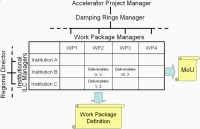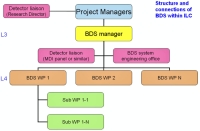Director's Corner
13 September 2007
 Barry Barish |
Towards organising the ILC engineering design effort
In order to have the strength and organisation we need to carry out an ILC engineering design over the next three years, the GDE Executive Committee has been carefully considering how to reorganise our efforts following completion of the Reference Design Report. Brian Foster, the GDE Regional Director for Europe, led the discussions within the Executive Committee, which also included open discussions at major GDE meetings and presentations to our Machine Advisory Committee. The key conclusions were that we needed to form a more traditional project management to guide the effort, to increase the number of engineering managers in key positions and to organise the work around formal work packages with the GDE institutions. As a next step toward achieving these goals, we appointed a task force to give us advice on implementing this plan. This week I received the report from this group. This task force report will now be discussed and fully taken into account in the first release of the EDR Project Management Plan we are formulating and will release later this fall.
The members of the EDR task force consist of Marc Ross (Chair, Fermilab), Ewan Paterson (SLAC), Bob Kephart (Fermilab), Andy Wolski (Cockroft Institute), Lutz Lilje (DESY), Katsunobu Oide (KEK), Hitoshi Hayano (KEK) and Nobu Toge (KEK). Andrei Seryi (SLAC) also made important contributions to the report.
 A possible model for damping ring organisation during the engineering design phase. A possible model for damping ring organisation during the engineering design phase. |
 The Beam Delivery System work-package leaders directly report to the BDS manager. The Beam Delivery System work-package leaders directly report to the BDS manager. |
The major conclusions of the panel as stated in the Executive Summary include:
- That the Engineering Design effort and the process of creating an Engineering Design Report can and should be executed with appropriate, formal controls and reporting, i.e. a line-management organisation
- That the line-management organisation for the Engineering Design effort above is viable through cooperation between the GDE management and the regional basis of resource support.
- That the Conventional Facilities and Siting efforts will naturally be divided into those that support development of a specific host site (regional) and those that support development of site-independent features. We believe that it is possible and practical to link these and manage them together, through the EDR Project organisation.
The report defines the primary deliverable of the engineering design phase as a written report - the Engineering Design Report. The goal of this EDR will be to provide countries with all required information so that a decision on how to proceed can be made.
The proposed time to publish the EDR is given as 2010, in anticipation of when initial LHC physics results and other accelerator R&D results will be available and all can be considered in deciding how to move forward with the ILC. The scope of the EDR will depend somewhat on the total available resources and we fully expect that additional engineering and R&D will be planned and required beyond the EDR. We expect that post-EDR programme to be accomplished both prior to and during the construction phase of the ILC.
The task force report analyses and proposes somewhat different detailed approaches for four discrete and important areas of the ILC design effort: the damping rings; main linac; beam delivery system; and conventional facilities and siting. These useful individual analyses provide important starting points for the meetings and discussions now underway in a series of kickoff meetings for the different areas of the ILC engineering design effort.
I would like to thank the task force for their hard work and important report that will help us get off on the right foot as we move forward. Developing an engineering design over the next three years that will provide the facts we need in order to propose the project to our governments is a very ambitious task. We must accomplish the major R&D goals needed to demonstrate the principle features of the design. We must develop a solid and detailed engineering design with value costing that will provide the basis for developing a detailed project implementation plan.
-- Barry Barish